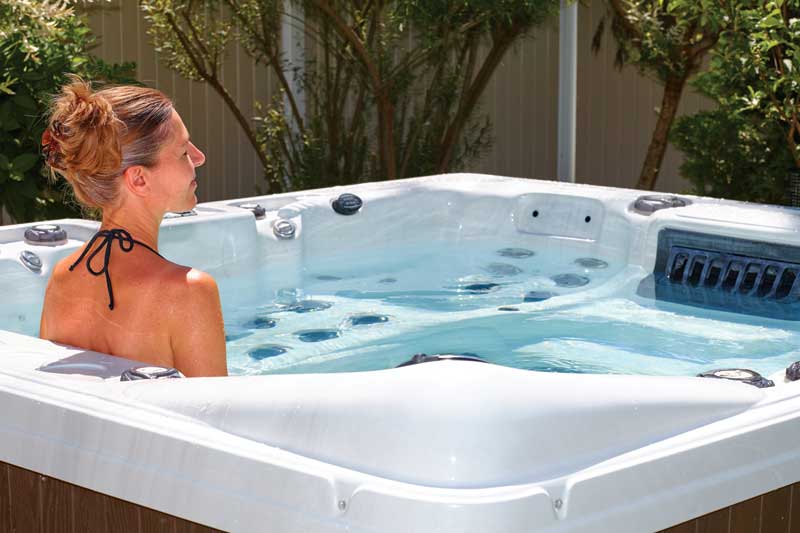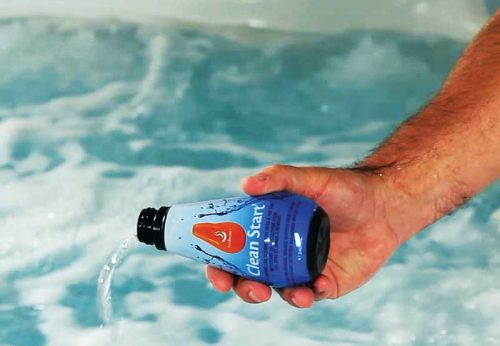Innovations in spa water care
by habiba_abudu | June 11, 2019 9:47 pm
By Colin Taylor, B.Sc.
 [1]
[1]Over the last two decades, spa manufacturers have been making luxury items with higher levels of craftmanship, advanced designs, better quality components, and many other improvements. Today, innovations, designs, and technologies continue to attract buyers to these backyard wellness products thanks to all the advancements manufacturers have made in regards to spa features and benefits.
While it may be the bells and whistles that initially attract many homeowners to spas, it is the experiences they have in the spa water that determine how often they return to their relaxing retreat. It is a simple proposition—if people enjoy their spa water, it will get continual use. If they do not, it will be retired.
Water care companies in the spa industry have taken notice, as well. As a result, many have developed products with the goal of making water care easier for consumers. While spa manufacturers have increased focus on high-tech accessories, chemical companies have centred their attention on products that work easily, effectively, and quickly. These spa water care innovations are positively shaping the future of the industry.
The latest trends in water care
A number of water care products have popped up over the past decade, which have positively affected the quality of spa water for consumers. What does this mean for retailers moving forward? One example is how spa water care companies have followed in the footsteps of those in the dishwasher and laundry detergent industries. These companies have converted their liquid and granular soaps into dissolvable packets. As a result, consumers have come to expect convenience and once-a-week chemical maintenance with products that work quickly.
These are great innovations and work toward making the hot water bathing experience better for spa owners. Further, these new products help keep spa water levels where they need to be for clean, comfortable water and provide an improved hot water bathing experience. These futuristic technologies also provide retailers with water care options that can help them build loyal customers who trust their products and purchase them on a repeat basis.
Easy as ABC
Water chemistry will always be paramount for spa owners; therefore, when the maintenance program can be minimized via scientifically proven and trusted methods, it leaves more time for people to reap the health and wellness benefits of their spas.
Today, retailers can help their customers spend less time with chemicals and more time enjoying the spas they purchased from them. It is a win-win scenario for all parties as the complexities often associated with water chemistry are eliminated.
When the correct amount of sanitizer is maintained in the water, paired with pre-measured, dissoluble water conditioning products that can simply be tossed into the spa, great water does not get much easier than this. Consumers do not have to handle harsh chemicals and shock as often as was necessary in the past. In fact, many spa owners have gained confidence in single-dose products that are pre-packaged as it eliminates the need for measuring and the potential for spilling while, at the same time, offering speed and convenience.
Green benefits of water care advancements
 [2]
[2]get much easier than this.
As a result of some modern water care innovations, a positive side effect has also created a green movement. In fact, some companies have won awards for their contributions to spa water chemistry because their products are not harsh and fall into a ‘green’ category of alternative spa water care.
Whether one is talking about dissolvable gems that help keep water balanced and soft, or proven plumbing line cleaners that eradicate biofilm and other buildup, when they are used in conjunction with each other, spa water will last longer. When spa water lasts longer, it does not have to be drained and refilled as often as in the past. Considering many units hold approximately 1900 L (500 gal) of water, and the number of people who own a spa, it adds up to saving a lot of water.
From a chemist’s perspective, this author believes these innovations work toward taking the uncertainty of spa water care almost entirely out of the hands of consumers who do not want to be burdened at home using products they are unfamiliar with and, many times, not getting the results they want.
Spa owners have lauded some of these newfangled products because they are realizing the health benefits of hot water bathing—without the headache of overbearing water care. Easy water care maintenance innovations are helping spa owners attain the desired water quality parameters in more convenient methods.
The past is the past
Prior to these advancements, it was commonplace for consumers to purchase a large amount of chemicals in various bottles that required constant measuring, pouring, and testing. It was up to them to figure out how to attain—and then consistently maintain—acceptable spa water levels. Balanced spa water is defined as: pH 7.2 to 7.6, alkalinity 80 to 120, hardness 100 to 250, and free chlorine 3 to 5 (or bromine 4 to 6, or salt 2 to 4).
Today, it is possible to combine any sanitizer with a dissolvable water-conditioning packet and the spa water’s pH will remain steady, allowing bathers to enjoy a relaxing soak in a spa full of soft-feeling water that is free of chemical odours and does not leave their skin dry or itchy. To ensure customers maximize the benefits of their spa, the water temperature should be plus/minus 32 C (90 F) and the sanitizer (chlorine, bromine, or salt) levels in the water should be properly maintained. This is necessary to eliminate bacteria, organic matter, and microbes that are introduced into the water by bathers.
It is also important for spa owners to understand: the more they use it, the quicker the sanitizer levels will be depleted. Further, if they do not want to smell chemicals while soaking in their spas, retailers should suggest customers add a water conditioner to neutralize these odours. These conditioners can also protect the components that produce jet streams and, as a result, keep them operating at peak performance. By ensuring efficient operation, spa owners can conserve energy and make sure their spa equipment lasts longer, which is another green benefit.
Retailers should also stress the importance of replacing the cover when the spa is not in use. This would protect the spa water from the elements and aid in water quality. Finally, when it is time to drain and refill the spa, a plumbing cleaner should be used to remove the buildup of organic deposit in the lines. Biofilm can clog jet streams; therefore, these lines should be purged so the homeowner can start clean and fresh when their spa is refilled.
People like spas for their versatility, health benefits, and potential for year-round usage as a temperature-controlled wellness retreat. The future of water care is here; there are numerous after-market options in water chemistry products that retailers can offer their customers to help make spa water care easier, giving them more time to indulge.
While it may be the bells and whistles that initially attract many homeowners to spas, it is the experiences they have in the spa water that determine how often they return to their relaxing retreat.
 [3]Colin Taylor, B.Sc., MIScT, is a chemist for SilkBalance, a hot tub water care company based in Vancouver, B.C. He has been involved in addressing several spa water maintenance problems and focused on resolving and simplifying some of them. Taylor also answers many e-mail questions from spa users around the world at watercare@silkbalance.com[4].
[3]Colin Taylor, B.Sc., MIScT, is a chemist for SilkBalance, a hot tub water care company based in Vancouver, B.C. He has been involved in addressing several spa water maintenance problems and focused on resolving and simplifying some of them. Taylor also answers many e-mail questions from spa users around the world at watercare@silkbalance.com[4].
- [Image]: https://www.poolspamarketing.com/wp-content/uploads/2019/06/bigstock-Beautiful-woman-relaxing-in-ho-135105095.jpg
- [Image]: https://www.poolspamarketing.com/wp-content/uploads/2019/06/CleanStartHandPouringInSpa.jpg
- [Image]: https://www.poolspamarketing.com/wp-content/uploads/2019/06/Taylor_Headshot.jpg
- watercare@silkbalance.com: mailto:watercare@silkbalance.com
Source URL: https://www.poolspamarketing.com/trade/features/innovations-in-spa-water-care/